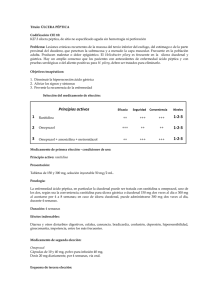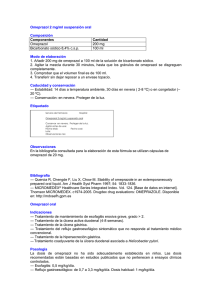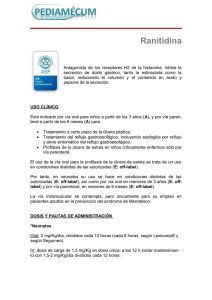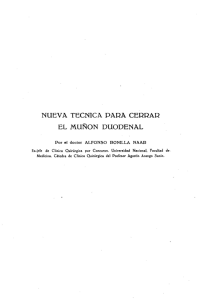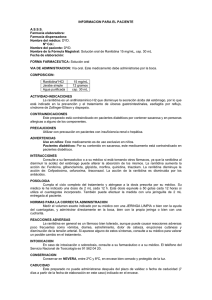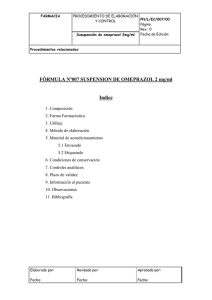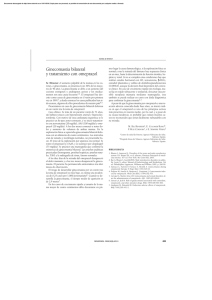antiulcerosos - Junta de Andalucía
Anuncio
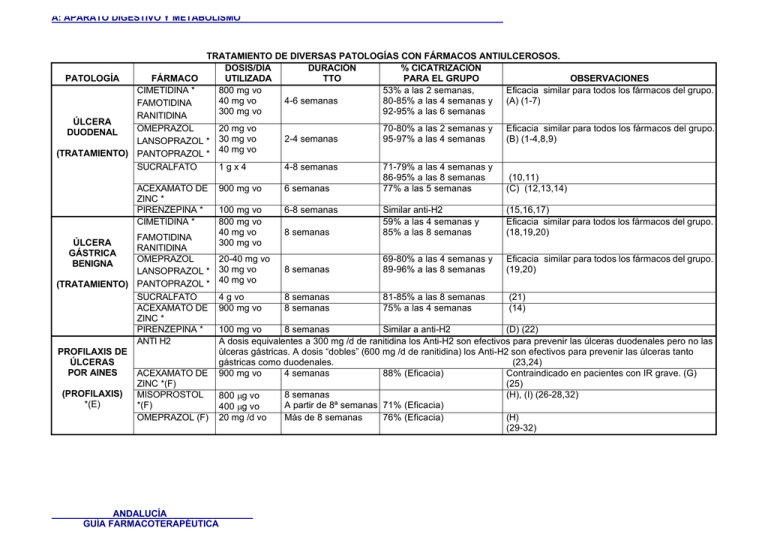
A: APARATO DIGESTIVO Y METABOLISMO TRATAMIENTO DE DIVERSAS PATOLOGÍAS CON FÁRMACOS ANTIULCEROSOS. DOSIS/DÍA DURACIÓN % CICATRIZACIÓN PATOLOGÍA FÁRMACO UTILIZADA TTO PARA EL GRUPO OBSERVACIONES 53% a las 2 semanas, CIMETIDINA * Eficacia similar para todos los fármacos del grupo. 800 mg vo 4-6 semanas 80-85% a las 4 semanas y (A) (1-7) 40 mg vo FAMOTIDINA 92-95% 300 mg vo a las 6 semanas RANITIDINA ÚLCERA 70-80% a las 2 semanas y Eficacia similar para todos los fármacos del grupo. OMEPRAZOL 20 mg vo DUODENAL 2-4 semanas 95-97% a las 4 semanas (B) (1-4,8,9) LANSOPRAZOL * 30 mg vo 40 mg vo (TRATAMIENTO) PANTOPRAZOL * SUCRALFATO 1gx4 4-8 semanas 71-79% a las 4 semanas y 86-95% a las 8 semanas (10,11) ACEXAMATO DE 900 mg vo 6 semanas 77% a las 5 semanas (C) (12,13,14) ZINC * PIRENZEPINA * 100 mg vo 6-8 semanas Similar anti-H2 (15,16,17) 59% a las 4 semanas y Eficacia similar para todos los fármacos del grupo. 800 mg vo CIMETIDINA * 8 semanas 85% a las 8 semanas 40 mg vo (18,19,20) FAMOTIDINA 300 mg vo ÚLCERA RANITIDINA GÁSTRICA 69-80% a las 4 semanas y Eficacia similar para todos los fármacos del grupo. OMEPRAZOL 20-40 mg vo BENIGNA 8 semanas 89-96% a las 8 semanas 30 mg vo (19,20) LANSOPRAZOL * 40 mg vo (TRATAMIENTO) PANTOPRAZOL * SUCRALFATO 4 g vo 8 semanas 81-85% a las 8 semanas (21) ACEXAMATO DE 900 mg vo 8 semanas 75% a las 4 semanas (14) ZINC * PIRENZEPINA * 100 mg vo 8 semanas Similar a anti-H2 (D) (22) ANTI H2 A dosis equivalentes a 300 mg /d de ranitidina los Anti-H2 son efectivos para prevenir las úlceras duodenales pero no las PROFILAXIS DE úlceras gástricas. A dosis “dobles” (600 mg /d de ranitidina) los Anti-H2 son efectivos para prevenir las úlceras tanto ÚLCERAS gástricas como duodenales. (23,24) POR AINES ACEXAMATO DE 900 mg vo 4 semanas 88% (Eficacia) Contraindicado en pacientes con IR grave. (G) ZINC *(F) (25) (PROFILAXIS) MISOPROSTOL 8 semanas (H), (I) (26-28,32) 800 µg vo *(E) *(F) A partir de 8ª semanas 71% (Eficacia) 400 µg vo Más de 8 semanas 76% (Eficacia) (H) OMEPRAZOL (F) 20 mg /d vo (29-32) ANDALUCÍA GUÍA FARMACOTERAPÉUTICA A: APARATO DIGESTIVO Y METABOLISMO ESOFAGITIS POR REFLUJO CIMETIDINA * FAMOTIDINA RANITIDINA OMEPRAZOL LANSOPRAZOL* PANTOPRAZOL * OMEPRAZOL ZOLLINGERLANSOPRAZOL* ELLISON SANGRADO RANITIDINA GASTROINTESTI NAL OMEPRAZOL PROFILAXIS DE CIMETIDINA * HEMORRAGIA GASTROINTESTI NAL POR ÚLCERA DE RANITIDINA STRESS SUCRALFATO 1600 mg vo 80 mg vo 600 mg vo 20-40 mg 30 mg 40 mg 6-12 semanas 35% a las 8 semanas y 47% a las 12 semanas 8-12 semanas 70-80 % a las 8 semanas 90- 97% a las 12 semanas Eficacia similar para todos los fármacos del grupo. (J) (33,34) Eficacia similar para todos los fármacos del grupo. (33-36,47-49) 20-180 mg 30-165 mg (37) 200-450 mg iv 80 mg iv (K) 300 mg iv bolus; inf. cont. de 37.5 mg /h Bolo 50 mg; inf. cont. 0.125-0.250 mg/Kg/h 4 g vo *. - Fármacos no incluidos en esta Guía. ANDALUCÍA GUÍA FARMACOTERAPÉUTICA Dosis mayores de las aprobadas en ficha técnica para vía parenteral. Dosis recomendadas en ficha técnica para esta indicación. (L), (M) (38-42) (N) (43) A: APARATO DIGESTIVO Y METABOLISMO (A) (B) (C) (D) (E) (F) (G) (H) (I) (J) (K) (L) (M) (N) Se han demostrado igual de efectivas 1 dosis nocturna que 2 dosis al día (44,45). 1 dosis diaria, con una comida, preferentemente en el desayuno (46). En dos ensayos clínicos se demuestra una efectividad análoga entre el acexamato de zinc y los anti H2 (13,14). En ensayo comparativo frente a cimetidina. Se acepta la prescripción de antiulcerosos al iniciar un tratamiento con AINES en pacientes con factores de riesgo como: edad > 70 años, antecedentes de úlcera péptica, coadministración de anticoagulantes o esteroides y enfermedad de base grave (IR, cirrosis hepática, EPOC, hiperparatiroidismo, etc.) (23,30). Para estos tres fármacos, los % de pacientes sin enfermedad no son co mparativos ya que mientras el ensayo con acexamato de zinc parte de un grupo de pacientes sin patología gastroduodenal previa, el ensayo que compara omeprazol y misoprostol parten de pacientes con patología gastroduodenal previa. Un único ensayo clínico (multicéntrico, doble ciego, en 276 pacientes en tratamiento con AINEs mostró una disminución del 92% (88% de pacientes sin síntomas) en la incidencia de úlcera gástrica y duodenal comparado con el placebo en pacientes en tratamiento con AINEs (34). En un ensayo clínico con 935 pacientes con lesiones ulcerosas, en los que se comparó el omeprazol (20 y 40 mg) frente a misoprostol en la prevención y tratamiento de las úlceras asociadas a AINEs, se demuestra que el porcentaje de curación de las úlceras gástricas y duodenales y las lesiones ulcerosas fue similar para las dos dosis de Omeprazol (20 y 40 mg /24h) que para el Misoprostol (200 µg /6h) y que en la terapia de mantenimiento, el 61% de los pacientes tratados con 20 mg de omeprazol permaneció con ausencia de enfermedad ulcerosa frente a un 48% de los que estaban tratados con 200 µg /12h de misoprostol. De estos últimos, un 59% presentó efectos adversos frente a un 46% de los tratados con 20 mg de omeprazol. Ambos fármacos se mostraron i gualmente efectivos para prevenir y tratar las úlceras duodenales, omeprazol fue superior en la prevención y tratamiento de úlceras gástricas y misoprostol fue superior en la prevención y tratamiento de pacientes con erosiones (32). En un metaanálisis publicado en 1996 en el que se comparan los tratamientos con misoprostol y con anti H2 en la profilaxis de úlceras inducidas por AINES se concluye que el misoprostol es efectivo en la profilaxis de lesiones gastrointestinales; que la actividad profiláctica d e los anti-H2 es pequeña o nula (excepto en profilaxis de úlcera duodenal en tratamientos a largo plazo), que sólo deberían ser tratados profilácticamente aquellos pacientes con alto riesgo de desarrollar patología gastrointestinal y que el tratamiento deb ería ser instaurado tan pronto como fuese posible ya que el riesgo de eventos adversos a la terapia con AINEs es alto en las primeras semanasanas de tratamiento. El número de pacientes a tratar (NNT) fue para el misoprostol de 35 a 47 pacientes cuando el r iesgo inicial de desarrollar patología digestiva era bajo (3%) mientras que disminuía a 3 -5 pacientes cuando el riesgo inicial era elevado (40%) (23). En un ensayo comparativo de omeprazol 20 mg frente a cimetidina 400 mg /6h en esofagitis por reflujo se observaron unos porcentajes a las 8 semanasanas del 71% (omeprazol) y 35 % (cimetidina) (47). Otro ensayo comparando omeprazol 40 mg y ranitidina 300 mg /12h dio como resultados, después de 12 semanasanas de terapia, unos porcentajes de cicatrización del 9 0% para omeprazol y del 47% para ranitidina (47-49). En varios ensayos sobre hemorragia gastrointestinal, el omeprazol a dosis altas (> 80 mg /d) se mostró superior a placebo y a los Anti-H2 a dosis altas (200-450 mg /d) en los porcentajes de cicatrizació n, en la necesidad de tratamiento quirúrgico o endoscópico y en la duración y severidad del sangrado (50 -56). Un metaanálisis recientemente publicado (62) indica que la utilización de agentes que disminuyen la acidez (preferentemente Anti -H2 e inhibidores de la bomba de protones) en hemorragias por úlcera péptica disminuye la tasa de resangrados y la tasa de cirugía pero no logra demostrar la existencia de efectos sobre la mortalidad. En un ensayo en 39 pacientes con hemorragia gastrointestinal aguda, debi da a úlcera gastroduodenal o de stress, se comparó ranitidina (bolo iv de 50 mg, seguido de infusión contínua de 400 mg /d durante 5 días) y omeprazol (bolo iv de 80 mg seguido de 40 mg /12h iv durante 5 días). El sangrado cesó en un 15% de los pacientes t ratados con ranitidina (n=20), frente a un 84% en los tratados con omeprazol (n= 19) (50) . En otro ensayo con ranitidina para evaluar la incidencia de resangrado en hemorragia gastrointestinal superior aguda (n= 158), no se encontraron diferencias significativas entre el grupo de ranitidina (150 mg /8h) y el de placebo excepto en el subgrupo de pacientes en que el sangrado era debido a úlcera duodenal (51) . Otro ensayo que estudiaba la recurrencia de sangrado en hemorragia gastrointestinal superior (no por varices), no encontró diferencias significativas entre ranitidina (50 mg iv /8h durante 3 días, seguido de 150 mg vo /12h) y omeprazol (40 mg iv /12h, durante 3 días, seguido de 40 mg vo /12h) (52). La ranitidina (50 mg iv /6h) demostró ser tan eficaz como la terapia de antiácidos (cada hora) en reducir la acidez gástrica y prevenir la recurrencia de úlcera de stress en pacientes críticos de UCI (57). La administración conjunta de ranitidina y antiácidos no parece producir beneficios adicionales (58). Los bolos intermitentes de anti H2 aumentan el pH gástrico por encima de 4 inmediatamente después de su administración pero el efecto es de aproximadamente 3 horas. Hay varios estudios que demuestran las ventajas de la infusión continua de anti H2 comparada con bolo intermitente en úlcera péptica activa, úlcera duodenal inactiva y profilaxis de úlcera de stress (51). ANDALUCÍA GUÍA FARMACOTERAPÉUTICA A: APARATO DIGESTIVO Y METABOLISMO (O) En un ensayo con 1.200 pacientes comparando sucralfato, 1g /6h vía nasogástrica, con ranitidina iv, 50 mg /8h, se observó que la ranitidina es más eficaz en prevenir el sangrado gastrointestinal, pero no encontró diferencias en los porcentajes de neumonías asociadas a ventilación mecánica (60). En un metaanálisis publicado en 1996 (59) se concluye que ranitidina es eficaz en disminuir la tasa de sangrado gastrointestinal y que parece existir una tendencia a favor de que los antiácidos también disminuyen esta tasa de forma superior a sucralfato. Que sucralfato es superior a Anti-h2 y a antiácidos en disminuir la frecuencia neumonía nosocomial y que se asocia a una disminución de la tasa de mortalidad cuando se compara con ranitidina o antiácidos (no hay suficiente evidencia en comparación con no tratamiento). Sin embargo, en un metanálisis recientemente publicado (61) se concluye que ni ranitidi na ni sucralfato previenen el sangrado gastrointestinal en pacientes en cuidados intensivos y que la ranitidina puede incrementar el riesgo de neumonía en estos pacientes en ciertas condiciones aunque manifiestan que los resultados obtenidos no son concluyentes. BIBLIOGRAFÍA 1- Marks IN, Danielewitz MD, Garisch JA. Comparison of omeprazole and ranitidine for duodenal ulcer in South African patients. A multiracial study. Dig Dis Sci Oct 1991;36(10):1395 -400. 2- Kager L, Limberg G, Nilsson LH, Seensalu R, Back man L, Gastrom L et al: The effect of omeprazole and ranitidine on ulcer healing, relief of symptoms, and incidence of adverse events in the treatment of duodenal ulcer patients. Hepatogastroenterology Aug 1991;38(4):287 -90. 3- Mulder CJ, Schipper DL. Omepr azole and ranitidine in duodenal ulcer healing. Analysis of comparative clinical trials. Scand J Gastroenterol Suppl 1990;178:62 -6. 4- Barbara L, Blasi A,Ckeli R, Corinaldesi R, Dobrilla G, Francaviilla A, et al. Omeprazole vs. ranitidine in the short-term treatment of duodenal ulcer: an Italian multicenter study. Hepatogastroenterology Oct 1987;34(5):229 -32. 5- Akhtar MA, Rashid P, Khan MA. Treatment of acute duodenal ulcers with famotidine and its comparison with other H2 blockers. J Pak Med Assoc Jun 1990;40(6): 136-7. 6- Simon B, Dammann HG, Jakob G, Miederer SE, Muller P, Ottenjann R, et al. Famotidine versus ranitidine in the acute treatment of duodenal ulcer. A multicenter comparative study in Germany. Z Gastroenterol Feb 1985;23(2):47-51. 7- Al-Mofleh I, Mayet I, Al-Rashed R, Al-Faleh F, Al-Aska AK, Laajam MA. Efficacy of single daily doses of H2 blockers in duodenal ulcer: Comparison of cimetidine and ranitidine in a double -blind controlled trial. Curr Ther Res Clin Exp 1989;46 (2):399-403. 8- Capurso L, Di PC, Bordi C, Koch M, La CP, Paoluzi P et al. Lansoprazole in the treatment of peptic ulcer disease: A multicentre double-blind study. Gastroenterology International 1996;8(3):125 -132. 9- Rehner M, Rohner HG, Schepp W. Comparison of pantoprazole versus omeprazole in the treatment of acute duodenal ulceration- a multicentre study. Aliment Pharmacol Ther 1995;9(4):411 -6. 10- Archimandritis A, Charitopoulos N, Diamantis T, Kitis G, Kokozidis F, Mallas E et al. Sulcralfate and ranitidine twice daily in the treatment of gastric ulcer. A multicenter randomized double -blind study. J Clin Gastroenterol Jun 1992;14(1): 8 -10. 11- Glise H, Carling L, Hallerback B, Kagevi I, Solhaug JH, Svedberg LE et al. Short -term treatment of duodenal ulcer. A comparison of sucralfate and cimetidine. Scand J Gastroenterol Apr 1986;21(3):313 -20. 12- Jimenez E, Bosch F, Galmes JL, Baños JE. Meta-analysis of efficacy of zinc acexamate of peptic ulcer. Digestion 1992;51(1):18-26. 13- Garcia-Plaza A, Arenas JI, Belda O, Diago A, Dominguez A, Fernandez C et al. E nsayo clinico multicentrico. Acexamato de zinc versus Famotidina en el tratamiento de la ulcera duodenal aguda. Grupo de estudio del Acexamato de zinc. Rev Esp Enferm Dig Nov 1996;88(11):757 -62. 14- Varas LMJ. Zinc acexamate and ranitidine in the short - and mid-term management of gastroduodenal ulcers . Curr Ther Res Clin Exp 1986;39 (1):19 -29. 15- Simjee AE, Bhoola RL: Pirenzepine and cimetidine for duodenal ulcers. A comparative randomised double -blind controlled study. S Afr Med J 1988 Nov 5;74(9):446 -7 16- Brunner H, Dittrich H, Kratochvil P, Brandstatter G, Hentschel E, Schutze K et al. Treatment of duodenal ulcer with pirenzepine and cimetidine. Gut Feb 1984;25(2):206-10. 17- Bianchi Porro G, Lazzaroni M, Mazzacca G, Piai G, Dal Monte PR, Colombo E, et al. Combined ranitidine and pirenzepine in the treatment of duodenal ulcer: a multicentre double -blind study using endoscopy. Journal of International Medical Research Sep-Oct 1990;18(5):341-50. 18- Hirschowitz BI, DeLuca V, Graham D, Lorber S, Bright -Asare P, Katon R. Treatment of benign chronic gastric ulcer with ranitidine. A randomized, double-blind and placebo controlled six week trial. J Clin Gastroenterol 1986; 8(3 Pt2):371 -6. 19- Di Mario F, Battaglia G, Leandro G, Grasso G, Vianello F, Vigneri S. Short -term treatment of gastric ulcer. A metaanalytical evaluation of blind trials. Dig Dis Sci Jun 1996;41(6):1108 -31. 20- Kagevi I, Anker-Hansen O, Carling L, Glise H, Hallerback B, Solhaug JH, et al. Swedish multicenter study on prepyloric and gastric ulcer. Scand J Gastroenterol Suppl 1987;127:67-76. ANDALUCÍA GUÍA FARMACOTERAPÉUTICA A: APARATO DIGESTIVO Y METABOLISMO 21- Hjortrup A, Svendsen LB, Beck H, Hoffmann J, Schroeder M. Two daily doses of sucralfate or cimetidine in the healing of gastric ulcer. A comparative randomized study. Am J Med Jun 1989;86(6A):113 -5. 22- Gonvers JJ, Realini S, Bretholz A , Voirol M, Arnold J, Birchler R, et al. Gastric ulcer: a double -blind comparison of 100 mg pirenzepine plus antacid versus 800 mg cimetidine plus antacid. Scand J Gastroenterol Sep 1986;21(7):806 -8. 23- Koch,M, Dezi A, Ferrario F, Capurso I. Prevention of non steroidal antiinflammatory drug induced gastrointestinal mucosal injury. A meta-analysis of randomized controlled clinical trials. Arch Intern Med 1996; 156(20):2321 -32. 24- Rostom A, Wells G, Tugwell P, Welch V, Dube C, McGowan J.The prevention of chronic NSA ID induced upper gastrointestinal toxicity: a Cochrane collaboration metaanalysis of randomized controlled trials. J Rheumatol Sep 2000;27(9):2203-14. 25- Rodriguez de la Serna A, Diaz-Rubio. Multicenter clinical trial of zinc acexamate in the prevention of no nsteroidal antiinflammatory drug induced gastroenteropathy. Spanish Study Group on NSAID Induced Gastroenteropathy Prevention. J Rheumatol May 1994;21(5):927 -33. 26- Koch M, Capurso L, Dezi A, Ferrario F, Scarpignato C. Prevention of NSAID -induced gastroduodenal mucosal injury: meta-analysis of clinical trials with misoprostol and H2 -receptor antagonists. Dig Dis Jan 1995;13 Suppl 1:62 -74. 27- Lanza F, Rack MF, Doucette M, Ekholm B, Goldlust B, Wilson R. An endoscopic comparison of the gastroduodenal injury seen with salsalate and naproxen. J Rheumatol Dec 1989;16(12):1570 -4. 28- Graham DY, Agrawal NM, Roth SH. Prevention of NSAID -induced gastric ulcer with misoprostol: multicentre, double blind, placebo-controlled trial. Lancet Dec 3 1988;2(8623):1277 -80. 29- Ekstrom P, Carling L, Wetterhus S, Wingren PE, Anker-Hansen O, Lundegardh G, et al. Prevention of peptic ulcer and dyspeptic symptoms with omeprazole in patients receiving continuous non -steroidal antiinflammatory drug therapy. A nordic multicentre study. Scand J Gastroenterol 1996;31(8):753 -8. 30- Prevención de las lesiones gastro -intestinales inducidas por AINES: utilización de antiulcerosos. Bol Ter And 1997; 13(2). 31- Antiulcerosos: actualización de sus indicaciones. Bol Ter And 1998; 14(3) 32- Hawkey CJ, KarraschJA, Szczepanski L, Walker DG, Barkun A, Swannell AJ et al: Omeprazole compared with misoprostol for ulcers associated with nonsteroidal antiinflammatory drugs. Omeprazole versus Misoprostol for NSAID induced Ulcer Management (OMNIUM) Study Group. N Engl J Med 1998;33 8(11):727-34. 33- Eriksson S, Langstrom G, Rikner L, Carlsson R, Naesdal J. Omeprazole and H2 -receptor antagonists in the acute treatment of duodenal ulcer, gastric ulcer and reflux oesophagitis: a meta -analysis. Europ J of Gastroenterol & Hepatol 1995;7(5):467-475. 34- Manzionna G, Pace F, Bianchi Porro G. Efficacy of lansoprazole in the short -and long-term treatment of gastro oesophageal reflux disease: a systematic overview. Clinical Drug Investigation 1997;14(6):450 -456. 35- Lundell L, Backman L, Ekstrom P, Enander LK, Falkmer S, Fausa O et al. Prevention of relapse of reflux esophagitis after endoscopic healing: the efficacy and safety of omeprazole compared with ranitidine. Scand J Gastroenterol Mar 1991;26(3):248-56. 36- Corinaldesi R, Valentini M, Belaiche J, Colin R, Geldof H, Maier C. Pantoprazole and omeprazole in the treatment of reflux oesophagitis: a European multicentre study. Aliment Pharmacol Ther Dec 1995; 9(6):667 -71. 37- Mignon M, Pospai D, Forestier S, Vatier J, Vallot T. Tr3eatement of patiens with Zollinge r-Ellison syndrome. Clin Ther 1993;15 Suppl B:22-31. 38- Santucci L, Fiorucci S, Pelli MA, Calderazzo A, Biasini E, Calderazzo PL et al. Control of gastric pH with ranitidine in critically ill patients. Comparison of two intravenous regimens. Dig Dis Sci. May 1991;36(5):583-7. 39- Ballesteros MA, Hogan DL, Koss MA, Isenberg JI. Bolus or intravenous infusion of ranitidine: effects on gastric pH and acid secretion. A comparison of relative efficacy and cost. Ann Intern Med Mar 1 1990;112(5):334 -9. 40- Frank W, Karlstadt R, Rockhold F, Palmer R, Malone M, Young M. Comparison between continuous and intermittent infusion regimens of cimetidine in ulcer patients. Clin Pharmacol Ther Aug 1989;46(2):234 -9. 41- Siepler JK, Trudeau W, Petty DE. Use of continuous infusion of histamine 2-receptor antagonists in critically ill patients. DICP Oct 1989;23(10 Suppl):S40 -3. 42- Sanders SW, Buchi KN, Moore JG, Bishop AL. Pharmacodynamics of intravenous ranitidine after bolus and continuous infusion in patients with healed duodenal ulcers. Clin Pha rmacol Ther. Nov 1989;46(5):545 -51. 43- Maier RV, Mitchell D Gentilello L. Optimal therapy for stress gastritis. Ann Surg. Sep 1994;220(3):353 -60; discussion 360-363. 44- Castelli G, Squassante L, Uleri S, Zanferrari G.: Different dosage regimens of ranitidine in the short-term therapy of duodenal ulcer: a multicentre trial. Int J Clin Pharmacol Res 1991;11(1):41 -9. 45- Lee FI, Reed PI, Crowe JP, McIsaac RL, wood JR. Acute treatment of duodenal ulcer: a multicentre study to compare ranitidine 150 mg twice daily with ranitidine 300 mg once at night. Gut Sep 1986;27(9):1091 -5. 46- USP DI Advice for the Patient. (14 ed) Vol 2. Rockville, Maryland: The United States Pharmacopeial Convention, Inc 1994. 47- Bate CM, Keeling PW, O’Morain C, Wilkinson SP, Foster DN, Mountford RA et al . Comparison of omeprazole and cimetidine in reflux oesophagitis: symptomatic, endoscopic, and histological evaluations. Gut Sep 1990;31(9):968 -72. ANDALUCÍA GUÍA FARMACOTERAPÉUTICA A: APARATO DIGESTIVO Y METABOLISMO 48- Lundell L, Backman L, Ekstrom P, Enander LH, Fausa O, Lind T et al: Omeprazole or high -dose ranitidine in the treatment of patients with reflux oesophagitis not responding to standard doses of H2 receptor antagonists. Aliment Pharmacol Ther 1990;4:145 -155. 49- Frame MH. Italian Reflux Oesphaguitis Study Group. Omeprazole produces significantly greater healing of er osive or ulcerative reflux oesophagitis than ranitidine. Eur J Gastroenterol 1991;3(7):511-7. 50- Brunner G, Chang J. Intravenous therapy with high doses of ranitidine and omeprazole in critically ill patients with bleeding peptic ulcerations of the upper inte stinal tract: an open randomized controlled trial. Digestion 1990;45(4):217-25. 51- Dawson J, Cockel R. Ranitidine in acute upper gastrointestinal haemorrhage. Br Med J (Clin Res Ed) Aug 14 1982;285(6340):476-7. 52- Mohamen SA, Karawi, MA: Omeprazole versus histam ine H2 receptor antagonists in the treatment of acute upper non variceal bleeding. Hepatogastroenterology Jul -Aug 1996;43(10):863-5. 53- Orti E, Canelles P, Quiles F, Zapater R, Cuquerella J, Ariete V, Tome A, Medina E.Is upper gastrointestinal bleeding evolution influenced by the used antisecretory?. Rev Esp Enf Dig 1995;87(6):427 -30. 54- Villanueva C; Balanzo J; Torras X; Sainz S; Soriano G; Gonzalez D; Vilardell F. Omeprazole versus ranitidine as adjunct therapy to endoscopic injection in actively bleeding ulcer s: a prospective and randomized study. Endoscopy May 1995;27(4):308-12. 55- Cardi M, Muttillo IA, Amadori L, Barillari P, Sammartino P, Arnone F, Signorelli C, Bolognese A . Intravenous omeprazole versus intravenous ranitidine in the treatment of bleeding duod enal ulcer: A prospective randomized trial. Annales De Chirurgie1997;51(2):136-9. 56- Schaffalitzky de Muckadell OB; Havelund T; Harling H; Boesby S; Snel P; Vreeburg EM; Eriksson S; Fernstrom P; Hasselgren G. Effect of omeprazole on the outcome of endoscopic ally treated bleeding peptic ulcers. Randomized double-blind placebo-controlled multicentre study [see comments]. Scandinavian Journal of Gastroenterology Apr 1997;32(4):320-27. 57- Noseworthy TW, Shustack A, Johnston RG, Anderson BJ, Konopad E, Grace M. A ran domized clinical trial comparing ranitidine and antacids in critically ill patients. Crit Care Med Sep 1987;15(9):817 -9. 58- Koelz HR, Aeberhard P, Hassler H, Kunz H, Wagner HE, Roth F et al. Prophylactic treatment of acute gastroduodenal stress ulceration. Low-dose antacid treatment without and with additional ranitidine. Scand J Gastroenterol Nov 1987;22(9):1147-52. 59- Cook DJ, Reeve BK, Guyatt GH, Heyland DK, Griffith LE, Buchingham L et al. Stress ulcer prophylaxis in critically ill patiens. Resolving discordant meta-analyses. JAMA Jan 24-31 1996;275(4)308-14. 60- Cook D, Guyatt G, Marshall J, Leasa D, Fuller H, Hall R et al: A comparison of sucralfate and ranitidine for the prevention of upper gastrointestinal bleeding in patients requiring mechanical ventilatio n. Canadian Critical Care Trials Group. N Engl J Med Mar 19 1998;338(12):791 -7. 61- Messori A, Trippoli S, Vaiani M, Gorini M, Corrado A. Bleeding and pneumonia in intensive care patiens given ranitidine and scralfate for prevention of stress ulcer: meta -analysis of randomised controlled trials. BMJ 2000;321 (7269):1103 -18. 62- Selby NM, Kubba AK, Hawkey CJ. Acid suppression in peptic ulcer haemorrhage: a ‘metanalysis’. Aliment Pharmacol Ther Sep 2000;14(9):1119-26. ANDALUCÍA GUÍA FARMACOTERAPÉUTICA
